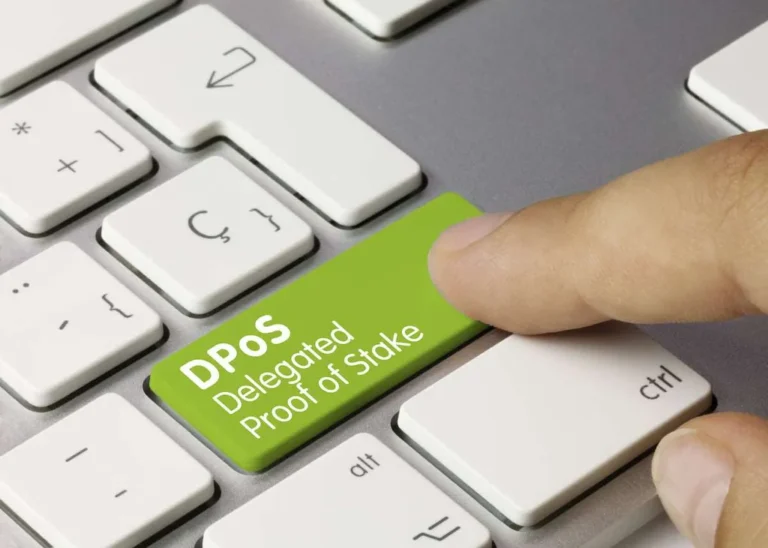The widespread adoption of the Proof of Stake (PoS) protocol resulted in improved transaction speed and reduced blockchain fees. It eliminates the need for complex mining operations and motivates holders to validate transactions. Thus, every elected individual safeguards the ledger’s integrity when performing their duties and actively engaging in the staking process. The introduction of the Delegated Proof of Stake (DPoS) model was accompanied by the creation of an optimized voting strategy. This detailed guide will explore the concept of DPoS and consider its practical implications. We will also analyze its prominent differences from other widely deployed algorithms.
How Does Delegated Proof-of-Stake Work?
DPoS is an improved variation of the traditional PoS system. This means that users will choose validators. When a block is produced, appointed participants reward those who vouched for them. The algorithm makes the whole governance procedure accessible and circumvents the issues plaguing the PoS framework. It diminishes the threat of single-point control and guarantees people with many coins won’t become monopolists.
As there aren’t many governance nodes producing blocks, DPoS is quite reliable. They can be elected and replaced by other participants. Users create staking pools and choose any representative they want to support. They do not need to transfer their funds to a particular address. They can rely on a reputable provider.
The main function of nodes lies in checking the accuracy of operations and confirming blocks to earn rewards. Users who stake a higher amount receive a more significant compensation. Here is how DPoS functions:
- Elections: Asset holders elect representatives during the voting procedure.
- Production: The nodes verify and confirm blocks, simplifying the procedure.
- Verification: Every block must be validated by a specific percentage of nodes. They add it to the distributed ledger. This method allows witnesses to reach an agreement regarding the transaction and strengthens the immutable record’s integrity.
- Agreement: Investors influence the process by voting for suitable representatives, with larger holdings granting them greater voting power.
- Rotation of representatives: Delegates are replaced regularly. This minimizes the risk of authority concentration and enhances security. Besides, it allows various individuals to take part in digital asset generation.
- Incentives and penalties: Consensus participants receive rewards through fees or crypto assets. Malicious or negligent users must pay hefty fines and may face a short suspension.
After discovering what is DPoS, it is clear why major projects leverage such a principle to ensure their continuous expansion. The method facilitates using an innovative consensus mechanism, resulting in higher ledger expansion potential.


Turnkey Brokerage Solution For Your Business
Get the most profitable fully licensed fx/crypto brokerage software or ready-to-operate business in 48 hours. Best-in-class web & mobile trading platforms, sales-driven CRM, full integration with MT4/5, and 150+ payment providers.
Pros and Cons of DPoS
Similar to traditional algorithms, DPoS has its upsides. It was devised to improve speed, achieve flexibility, and ensure fair access to the ledger by lowering hardware requirements.
Nonetheless, the advanced solution also has its shortcomings. Its critics argue that holders can exploit it. Besides, it necessitates constant engagement and favors the holders with many tokens. Let’s consider the concept in detail. It will help us clarify whether it is more effective than Proof of Work (PoW) and other traditional algorithms.

Here are the main factors ensuring the popularity of the algorithm:
- Growth potential: The model’s use facilitates expediting execution speed. As the number of top nodes is small, networks deploying the principle are easier to scale.
- Energy efficiency: PoW relies on complicated crypto hashing. The Delegated Proof of Stake model has a less noticeable environmental impact and does not require a lot of processing capacity.
- Equitable strategy: The algorithm relies on democratic governance practices and enables holders to choose suitable delegates. It facilitates maintaining decentralization while achieving network efficiency. Due to transparent rules, the blockchain becomes safer.
- Top-grade safety: The list of main nodes is finite. Representatives get regularly re-elected.
- Incentives: Stakeholders are rewarded for swift action and following the rules, which improves the protocol’s reliability.
- Irreversible transactions: When a block is added, this step cannot be reversed, making the strategy popular among app developers. They build solutions supporting high-speed transactions that cannot be canceled.
- Regular upgrades: The agreement method can be changed without a protocol upgrade, which optimizes the ledger’s development.
- High engagement: Investors willingly participate in processes and adopt a responsible course of action. Voting is extremely intuitive, further encouraging the participation of asset owners.
Besides, DPoS empowers users to predict when new blocks will be produced. It helps developers and regular traders understand when their transactions will be verified. Even though the model facilitates decision making, it has several notable shortcomings.
- Administrative consolidation: Elected individuals confirm transactions and generate new blocks. Unless they are frequently replaced with fresh members, this may give rise to power concentration.
- Vote buying: Since investors with large holdings have significant voting power, this can lead to the formation of organized groups engaging in manipulative practices. Some malicious investors may be tempted to purchase new tokens to impact the election process. Such actions compromise the blockchain’s integrity.
- Low incentive for those with limited funds: Participants who do not hold many coins are less interested in voting as they realize their voice does not have a significant power. If many users stop participating in governance, it may lead to higher centralization.
- Reliance on credibility: The concept focuses on the delegates’ reputation to achieve higher trustworthiness. If their reputation is damaged, it negatively impacts the whole ecosystem.
- Complex governance practices: It is arduous to ensure the appointment of new governing nodes and align the wishes of stakeholders.
- A threat of error: Only a few participants confirm transactions. If any of them fail to fulfill their obligations, it may affect the whole network.
Despite these serious issues, many projects utilize the model because they can adapt it to their specific objectives.
DPoS in Practice
Steem, EOS, and BitShares utilize the Delegated Proof of Stake principle, which supports an inclusive method of approving operations and achieving top-grade security. However, each project embraced a contrasting implementation method, allowing them to reach their specific objectives.
DPoS functioning varies depending on the project. Although there are multiple ways of implementing the algorithm, its basic principles remain the same. By balancing decentralization with efficiency, DPoS ensures faster transaction processing and scalable network performance. It also allows participants to achieve consensus democratically.
DPoS vs. Other Consensus Mechanisms
Unlike PoW and PoS, the Delegated Proof of Stake model streamlines the process of validating operations. Its well-thought-out voting procedure ensures fairness. Nonetheless, it requires constant engagement and benefits those who own many tokens. Its key difference from the Nominated Proof of Stake (NPoS) principle is that it allows individuals to choose representatives directly. In contrast, NPoS implies validators will be nominated by stakeholders but elected by the algorithms based on their reputation.
DPoS systems are secure as long as voters elect the right delegates. NPoS blockchains rely on algorithmic security checks and unbiased elections of authoritative candidates. Due to its versatility, DPoS became integral to multiple blockchains, demonstrating its significance.






